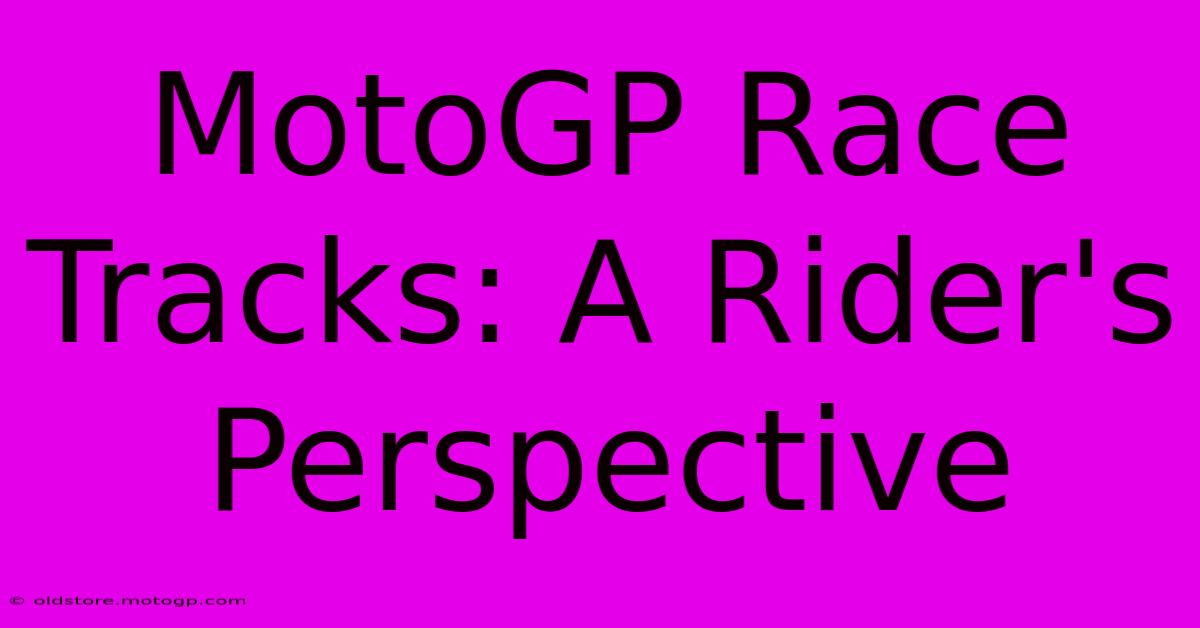MotoGP Race Tracks: A Rider's Perspective

Table of Contents
MotoGP Race Tracks: A Rider's Perspective
For MotoGP riders, a race track is more than just asphalt and tarmac; it's a canvas upon which they paint their skill, courage, and precision. Each circuit presents a unique challenge, demanding a specific riding style and demanding meticulous preparation. Let's delve into the world of MotoGP race tracks from the rider's point of view.
The Anatomy of a MotoGP Track
A MotoGP track isn't just a collection of turns; it's a complex interplay of high-speed straights, technical corners, elevation changes, and crucial braking zones. Every detail—from the camber of a corner to the texture of the tarmac—can make or break a rider's performance.
High-Speed Sections: A Test of Nerve
Straights demand unwavering focus and throttle control. Riders need to manage the immense speed, ensuring stability while preparing for the upcoming braking zones. A slight wobble at 300 km/h can be catastrophic. Top speed isn't just about power; it's about aerodynamic efficiency and bike stability at extreme velocities. The feeling of being propelled forward at such speeds is exhilarating, but demands absolute control and precision.
Technical Corners: Precision and Feel
These sections demand finesse and precision. Riders navigate these corners using a combination of lean angles, throttle control, and precise braking. Feeling the grip of the tires and reacting to subtle changes in the track's surface is paramount. Corner entry is critical; a rider's ability to find the ideal line and maintain momentum is crucial for gaining an advantage over their competitors. This intricate dance between bike and rider is a mesmerizing ballet of skill and precision.
Elevation Changes: A Wild Ride
Tracks like Austria's Red Bull Ring and the Circuit of the Americas in Austin, Texas showcase significant elevation changes. These variations alter the bike's handling and dynamics, demanding even greater control and adaptability from the rider. Riding uphill and downhill requires different braking points, cornering techniques, and a keen understanding of the bike's behavior in these dynamic situations. Elevation change adds another layer of complexity, testing not just riding skills but physical endurance as well.
Braking Zones: The Art of Controlled Deceleration
Braking zones are high-pressure moments where riders must reduce their speed dramatically before entering a corner. The ability to brake hard while maintaining stability and control is essential. Braking points are often determined by track conditions, tire temperature, and even the feel of the bike. A single mistake here can lead to a crash or a significant loss of time.
Track Specifics: Examples of Iconic Circuits
Each MotoGP track boasts a unique character that shapes the racing strategy and rider techniques. Let's consider a few examples:
- Mugello (Italy): Known for its long, flowing corners and high-speed straights, Mugello demands a balance of speed and precision. Mugello's fast sections require aggressive riding but also a careful approach to braking.
- Assen (Netherlands): Often called the "Cathedral of Speed," Assen is famous for its fast, flowing layout and unpredictable weather conditions. Assen's unique layout forces riders to be incredibly adaptable.
- Laguna Seca (USA): The iconic "Corkscrew" turn is a testament to the track's challenging nature. This section requires immense bravery and skill from riders. Laguna Seca's elevation changes are particularly demanding.
The Mental Game: Riding on the Edge
The mental aspect of riding a MotoGP track shouldn't be overlooked. The pressure of competition, the need for unwavering focus, and the constant risk of a crash demands significant mental strength. Mental preparation is just as important as physical training for MotoGP riders. It's a battle of nerves as well as a test of physical skill.
Conclusion: A Symphony of Speed and Skill
MotoGP race tracks are more than just venues for racing; they are tests of skill, courage, and precision. The riders' perspective underscores the complexity and challenge of navigating these demanding circuits, making each race a thrilling spectacle of human skill and machine power. Understanding the nuances of each track, from the high-speed straights to the intricate corners, is key to success in the world of MotoGP.

Thank you for visiting our website wich cover about MotoGP Race Tracks: A Rider's Perspective. We hope the information provided has been useful to you. Feel free to contact us if you have any questions or need further assistance. See you next time and dont miss to bookmark.
Featured Posts
-
Moto Gp Top Speed Adrenaline On Two Wheels
Feb 21, 2025
-
F1 Qualifying Cota The Pressure Is On
Feb 21, 2025
-
Moto Gp Race Tracks A Celebration Of Innovation And Engineering
Feb 21, 2025
-
Moto Gp Starting Grid The Importance Of Clutch Control
Feb 21, 2025
-
Lot F Cota Simplifying Your Life
Feb 21, 2025
